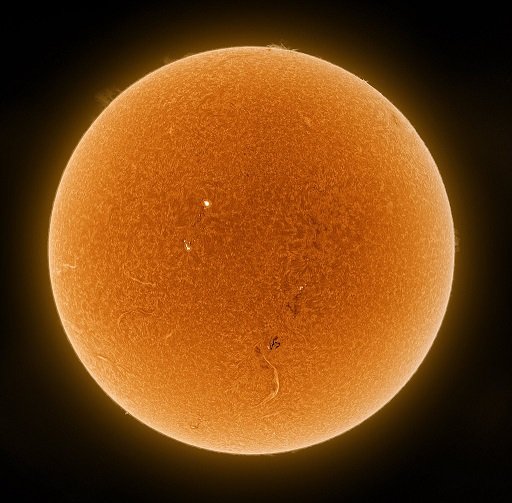WARNING! Never look at the Sun through a telescope without the correct equipment. You will cause serious damage to your eyes and potentially go blind.
I cannot express the seriousness of that warning message. Below is a very graphic video of what will happen to your eyes if you look at the Sun through a telescope, and the result is pretty disgusting!
Within seconds, your cornea will start to burn and cause irreparable damage to your eye.
Why you Shouldn’t Look at the Sun Through a Telescope
Well, if the above warning messages haven’t scared you off, let’s look at this in more detail.
Using a camera lens, binoculars or a telescope to view the sun is incredibly dangerous. That’s because they will focus the sun’s rays more than your eyes can. The video below shows what happens if you use a small telescope and point it towards the sun without the correct protective equipment.
You can see that in just a few seconds, the eyepiece starts smoking as the plastic begins to melt. That’s because the telescope is focusing the sun’s rays into a very narrow objective, making them much more powerful than just looking at the sun with just your eyes – which you should also never do either!
Now, imagine that eyepiece was your eye! What do you think the lasting damage would be? Well, below we have a video from Astronomy Mark that shows exactly what will happen to your eye if looking at the sun through a telescope.
Don’t worry though, he’s not sacrificing his own eyes. He got a pig’s eye from the butchers to demonstrate. Pig’s eyes are most like humans, so this test is the perfect example of what would happen to a human eye.
WARNING! This video is rather graphic and not for the faint hearted.
As you can see, while nothing appeared to happen for the first few seconds, after a short while the eye began to smoke. The sun had burned a hole straight through the cornea of the eye, all the way to the retina.
I want to add, that while nothing appeared to happen for a few seconds, the damage to the eye would have been almost instant in terms of damage to eyesight.
This is a pretty catastrophic result, and if that was your eye, you’d certainly be left blind. Not to mention having a big hole in your eye! That is why it is so important to NEVER look at the sun through a telescope, camera lens or binoculars.
How to View the Sun Safely Through a Telescope
With all those warnings and disclaimers out the way, you’re probably wondering if there’s a safe way you can view the sun through a telescope. Well fortunately, yes you can!
Visual Solar Observing
There are specialist filters you can buy, such as a Baader Solar Film, or a Herschel wedge that provide the proper protection to observe the sun. A Baader solar film will give you the protection your eyes need, by reducing the intensity of the sunlight by 99.999% while still giving you excellent views of our nearest star.
There are still some things to adhere to that will always ensure your safety when observing the sun with a solar film.
1. Hold up the solar film to the sky to check for pin holes or scratches. Checking for damage this way will protect your eyes and save you from finding out there’s an issue when you look through the eyepiece!
2. Point your telescope away from the sun to apply the filter. It’s important you don’t damage your optics by pointing your telescope at the sun before fitting the solar filter.
3. To ensure safety, apply some heat resistant duct tape on the edges of the solar filter bracket. This will ensure it’s secure to your telescope and minimises the risk of the solar filter falling off while observing through the eyepiece.
4. It’s then important to double check everything before pointing your telescope towards the Sun.
5. Now you’re ready to safely observe.
Astrophotography Solar Observing
It’s also possible to take images of the Sun with a telescope. This can be done one of two ways, either using a dedicated solar telescope such as a Lundt or using a DayStar Quark filter. Neither option is particularly cheap, but that’s astrophotography for you!
A Lundt telescope or DayStar Quark filter are specialist solar equipment that will protect your camera from the sun’s rays as they are optimised for capturing light in Hydrogen Alpha.
You will also require a UV/IR cut filter that will reflect UV and IR light back out of the telescope and keep the temperature inside your optical assembly cool. However, if the aperture of your telescope is 120mm or above, you will need to buy an Energy Rejection Filter, which prevents almost all heat from entering the telescope.

Solar imaging is often captured as short, individual video files that are then stacked together using software to provide more detail in the final image. Capturing the sun in this way also means you can create short videos or GIFs to share on social media. This is great for showing off prominences on the Sun! You can really capture how active the sun is when capturing video.
The incredible image above by AstroMatt is a perfect example of what is possible to capture using a refractor telescope and a DayStar Quark filter. Capturing the Sun in this detail requires a camera capable of capturing video at a high frame rate. The ZWO ASI432MM that Matt uses is perfect for solar imaging, especially when paired with a William Optics GT-71, but I would say that because I own one too!
